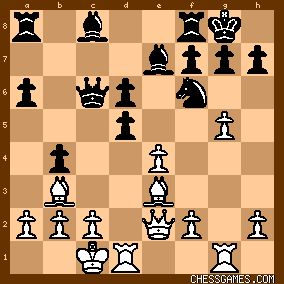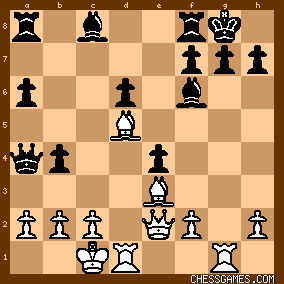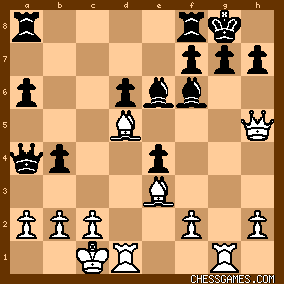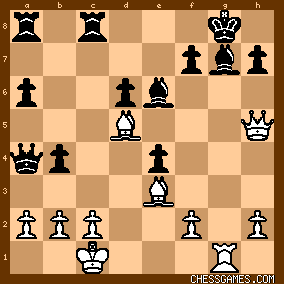|
< Earlier Kibitzing · PAGE 4 OF 4 ·
Later Kibitzing> |
| Apr-17-12 | | qqdos: The game should be correctly attributed and the actual Ostapenko found and given due credit! According to 365Chess.com there is another Ostapenko, Alexander from the Russian Federation ELO 2237 born 1962, perhaps the brother of Dmitry, also from the RF but given an ELO of 2260. Where on earth did CG.com get their ELO ratings from? - 2565 for Dmitry?? and 2350?? for Pavel Yartsev, who unjustly has the millstone of this spectacular loss hanging around his neck. That cannot be condoned. The true Ostapenko (possibly father of Dmitry and Alexander) clearly knew the theory and the recent game I cited. If Dmitry did actually play this game, then you cannot escape the fact that he was aged 9 at the time and beat a child of 5. Until the actual participants have been identified, how about re-titling the game Ostapenko (?) vs NN, 1969 Russian Federation? |
|
Apr-17-12
 | | LIFE Master AJ: <<Apr-17-12 qqdos: The point is that this game has been mis-attributed and the moderator of CG.com should take note.>> All your mistaken assumptions.
The only thing I see - that is probably incorrect - is the birth date for Ostapenko. (That might be the son, but not the Dad.) I am sure what happened- when this game was submitted - is that they went looking for Internet records for this player. (They probably got the wrong one.) |
|
Apr-17-12
 | | LIFE Master AJ: BTW, my web page, (http://www.angelfire.com/games3/lif...); contains a very detailed analysis of this game. The bibliography also quotes three books - none of them are the Informant. |
|
| Apr-17-12 | | JoergWalter: <LMAJ> pretending to know something about the players or just copying from other authors again? <Dmitry Ostapenko was a very strong player, probably at least IM strength. (He played
in at least one Soviet Championships Semi-Finals.) He played several beautiful games
of chess. He wrote articles for chess magazines, and probably played postal chess, but
not much else is known about this player. (A search of my database shows that he
played in the Soviet Semi-Finals as recently as 1998.) Pavel Yartsev was not as strong as his opponent, but may not have been allowed to play
as much ... as he was Jewish. He later immigrated to Israel, where he lives today.> Where did you pull this out, <LMAJ>? |
|
| Apr-17-12 | | qqdos: What was the event in 1969 in which this game was played? And what were the first names of the respective players? "Verify" those details and then let us see whether this game has been mis-attributed. <JW> thnx for the quotes! |
|
| Apr-17-12 | | cro777: Yakov Damsky in his book about chess aesthetics (in Russian) commented on the game Ostapenko - Yartsev (Остапенко — Ярцев). He said that they were not even masters. For him the game is an example that "ordinary" players in an "ordinary" tournament (one of thousand similar tournaments) can sometimes create a chess masterpiece. There are no data about Yartsev's first name and his opponent was Alexander (and not Dmitry) Ostapenko. |
|
| Apr-18-12 | | qqdos: thnx. With the amendment I have suggested on the Yartsev page, we can have a simple (hope bureaucracy won't intervene) correction with justice seen to be done all round and without expunging this grand game from chess history! I suppose new pages will be needed for Alexander Ostapenko's 1960-70's games and for Dmitry's more recent game(s). That leaves the nagging question of <JW's> (to whom many thnx also) possible hoax theory on which I am agnostic now that we can eliminate schoolboy accomplices. Alexander is entitled to all the plaudits! |
|
| Apr-18-12 | | cro777: <qqdos> You are quite right. I agree completely. |
|
| Apr-18-12 | | King Death: <qqdos> is an agnostic? Off with his head! |
|
| Apr-18-12 | | qqdos: <KD> Quite! |
|
| Apr-19-12 | | cro777: The game Ostapenko - Yartsev (USSR 1969) was a correspodence chess game. Yuri Yakovich confirmed that in his book "Sicilian Attacks" (New In Chess, 2010). According to Yakovich, to this day, despite the help of computers, the assessments of many of the very sharp positions arising from the Velimirovic Attack are not clear. And on the game Ostapenko - Yartsev he commented:
White pawn advances to g5 without support of other pawns. Velimirovic Attack. Position after 15.g5

click for larger view
"The attempt to organise counterplay by
15...dxe4 16. gxf6 Bxf6 17. Bd5 Qa4

click for larger view
is refuted by the brilliant
18. Qh5! Be6 19. Rxg7+!!" |
|
| Apr-19-12 | | cro777: It is perfectly understandable that there were players who wanted to repeat the masterpiece. Position after 18...Be6

click for larger view
In correspondence chess, the diagram position arose in five games (in the period from 1971 to 1995). Widera Jan - Jaksa Zygmunt (POL 1971)
19. Rxg7+ Bxg7 20. Rg1 Rfc8 21. Rxg7+ Kxg7 22. Qh6+ Kg8 23. Bxe4 b3 24. Bxh7+ Kh8 25. Bf5+ Kg8 26. Qh7+ Kf8 27. Bh6+ Ke8 28. Qg8+ Ke7 29. Bg5+ Kd7 30. Qxf7+ Kc6 31. Bxe6 Kb6 32. Be3+ Ka5 33. Bxc8 Rxc8 34. Qf5+ Rc5 35. Bxc5 Qb5 36. Bb6+ Kxb6 37. Qxb5+ axb5 38. axb3 1-0 Jantunen, Olli - Perala, Bror (FIN 1971)
19. Rxg7+ Bxg7 20. Rg1 Rfc8 21. Bxe4 Kf8 22. Rxg7 Rxc2+ 23. Bxc2 Rc8 24. Rg8+ Kxg8 25. Qxh7+ Kf8 26. Qh8+ Ke7 27. Qxc8 1-0 Niemand, Gerhard - Gerold, Guenter (GER 1977)
19. Rxg7+ Bxg7 20. Rg1 Rfc8 21. Rxg7+ Kxg7 22. Qh6+ Kg8 23. Bxe4 b3 24. Bxh7+ Kh8 25. Bf5+ Kg8 26. Qh7+ Kf8 27. Bh6+ Ke8 28. Qg8+ Ke7 29. Bg5+ Kd7 30. Qxf7+ Kc6 31. Bxe6 Qe4 32. Qd7+ Kb6 33. Be3+ Ka5 34. Bxb3 Rc6 35. c3 Rac8 36. Bc2 Qh1+ 37. Kd2 Qd5+ 38. Kc1 Qh1+ 39. Bd1 Rxc3+ 40. bxc3 Rxc3+ 41. Kd2 Rxe3 42.
Qa4+ Kb6 43. Qd4+ Kc6 44. Kxe3 Qxh2 45. Qa4+ Kb6 46. Qf4 Qh3+ 47. Kd2 Qd7
48. Qd4+ 1-0
Sinacori Antonino (ITA) - Scholz Harald (GER 1990)
19. Rxg7+ Bxg7 20. Rg1 Rac8 21. Rxg7+ Kxg7 22. Qg5+ Kh8 23. Bd4+ f6 24. Bxf6+ Rxf6 25. Qxf6+ Kg8 26. Bxe6# 1-0 Tichy, Josef - Hejna, Jiri (CZE 1995)
19. Rxg7+ Bxg7 20. Rg1 Rfc8 21. Rxg7+ Kxg7 22. Qh6+ Kg8 23. Bxe4 f6 24. Bxh7+ 1-0 |
|
| Apr-19-12 | | cro777: In 2009, at the Dhaka BAN 35th Men Champioship (Dhaka, Bangladesh) <Reefat Bin-Sattar> and <Ahmed Jamal> repeated the game Ostapenko - Yartsev until move 20. Position after 20...Rfc8

click for larger view
Here, instead of <21.Rxg7+>, Reefat played <21.Bxe4> and the game continued 21. Bxe4 f5 22. Qh6 Rc7 23. Bd4 Raa7 24. Qxe6+ Kf8 25. Bxg7+ Rxg7 26. Qxd6+ Rge7 27. Bd5 1-0 Reefat Bin-Sattar is a Grandmaster from Bangladesh (the third grandmaster that emerged from the country). He was champion of Bangladesh six times and represented Bangladesh in seven Chess Olympiads, from 1994 to 2006. |
|
| Apr-20-12 | | qqdos: <cro777> I believe I detect a fellow (B89) groupie! What a plethora of info. All attempts to refute 19.Rxg7 seem doomed. So Alexander Ostapenko was a correspondence player, presumably from what is now the Russian Federation. I fear Reefat's 21.Be4? is a mistake and Jamal should have played 21...Kf8 or 21...b3 in both cases gaining an advantage. Instead 21...f5?? blundered it away, followed by 22...Rc7? and 23...Raa7?? allowing a mate in 14! Reefat found the right follow-up, but not the direct route to mate with 25.Qxf5+! A lucky lad. He got back on track, after 25...Rge7?? (the other rook would have delayed the end), with 27.Bd5 # in 5 and caput. |
|
| Apr-21-12 | | cro777: <qqdos: I believe I detect a fellow (B89) groupie!> Obviously you have the technical and functional expertise to become a chess history detective. An idea just came to my mind. GM Mikhail Golubev might provide us with useful information about Alexander Ostapenko and his games against Yartsev and Kurkin. He uses to visit his player page. Today he posted necessary links. Mikhail Golubev http://mikhailgolubev.wordpress.com/ |
|
| Apr-22-12 | | qqdos: <cro777> many thnx. Unfortunately GM Golubev cannot help - he is not aware that there were 2(3) Ostapenkos. Meanwhile there is another (B89) correspondence game, the full score of which, I would like to track down: see recent entries at Dragoljub Velimirovic above. It is "Velimirovic vs Herzog, Corres. 1960-1" cited on p.53 of the Tim Harding et al. book on the Sozin. It would be a historic game if this was the first outing of his trademark Attack by Drasko himself, at the time 18 or 19! |
|
| Apr-22-12 | | cro777: <qqdos: Tim Harding can find no postal games by Drasko but there was an R. Velimirovic playing correspondence chess.> There was Ratko Velimirovic playing correspondence chess. In 1979 he played against Marjan Semrl. Velimirovic, Ratko - Semrl, Marjan (corr Yugoslavia, 1979) Last year Marjan Semrl (now citizen of Slovenia) became the 24th Correspondance Chess World Champion. You may contact him (Marjan Semrl [Krjavelj]): krjavelj.chess@gmail.com
More information about Semrl you may find here
http://www.squidoo.com/computer-che...
I have two correspondence games of Dragoljub Velimirovic, against Stein (1972) and Perovski (1991). Unfortunately, there is no game Velimirovic - Herzog in CC database. |
|
| Apr-22-12 | | cro777: The following correspondence game might be interesting as an early example of the Velimirovic Attack Bohak, Janko - Nikolic, B.
(corr Yugoslavia, 1960)
1. e4 c5 2. Nf3 d6 3. d4 cxd4 4. Nxd4 Nf6 5. Nc3 Nc6 6. Bc4 e6 7. Be3 a6 8.Qe2 Qc7 9. Bb3 Bd7 10. O-O Be7 11. Rad1 O-O 12. Rd2 Nxd4 13. Bxd4 Bc6 14.f3 Nd7 15. Rfd1 Rad8 16. Nd5 exd5 17. exd5 Bg5 18. dxc6 Bxd2 19. Qxd2 bxc6 20. Qc3 Ne5 21. f4 c5 22. Bf2 Ng4 23. Bh4 Rde8 24. Qg3 Ne3 25. Rd5 Nxd5 26.Bxd5 c4 27. Bf6 Qc5+ 28. Kf1 g6 0-1 |
|
| Apr-23-12 | | qqdos: <cro777> You are a mine of information! Thnx a bundle. I will examine the games you cite. Meanwhile, reverting to the Ostapenko game, GM Golubev at p.178 of his 2001 book on the Sozin gives Ostapenko vs Yartsev, corr. 1969 - no initials. |
|
| Apr-23-12 | | qqdos: Back to Bohak vs Nikolic, 1960. True White does get his Queen to e2 but takes 2 moves to castle and bring his Ra-to-d1. The WK meanwhile on g1 is going to inhibit an attack on the BK, e.g. with g4; g5; h4; supported by Rooks on g1 or h1 etc. I was looking for the games which might have inspired Velimirovic and his mother when they were perfecting his Attack. The earliest example I could find was this: Nezhmetdinov vs Krogius, 1959, with all the key moves but which appears to have been largely ignored despite its historic significance to (B89) theory. |
|
| Apr-23-12 | | cro777: <qqdos: I was looking for the games which might have inspired Velimirovic and his mother when they were perfecting his Attack.> In the 60's, Yugoslav grandmasters of aggressive style, particularly Dragoljub Velimirovic and Milan Matulovic, analyzed deeply offensive systems against the Sicilian Defence. |
|
| Apr-23-12 | | qqdos: <cro777> I reckoned this game R Bogdanovic vs J Rejfir, 1962 was probably Drashko's "local" inspiration for his Attack, unless of course Bogdanovic knew our elusive 1960 postal game. |
|
| Apr-23-12 | | qqdos: <Matulovic> aggresive style - <JoergWalter> may be interested in this game because of the role of Nikitin, establishing that he was playing and analysing this very line 3 years before the Ostapenko vs Yartsev game! Matulovic vs Nikitin, 1966 where the VA is played, deploying the advance 13.g5 two moves earlier than Ostapenko, who chose 13.Nxc6. |
|
| Apr-23-12 | | cro777: <qqdos> I'm sure that the game Nezhmetdinov - Krogius was deeply analyzed by Yugoslav players. Rajko Bogdanovic may be was the first to apply the idea in an international tournament but they all used the same sources. |
|
| Sep-05-13 | | Kinghunt: Stockfish 4 finds 21. Rxg7+ in two seconds flat. Kind of scary to think about, really. |
|
 |
 |
|
< Earlier Kibitzing · PAGE 4 OF 4 ·
Later Kibitzing> |





































